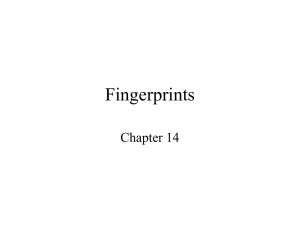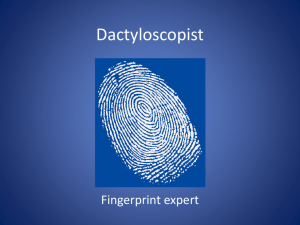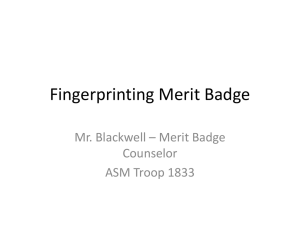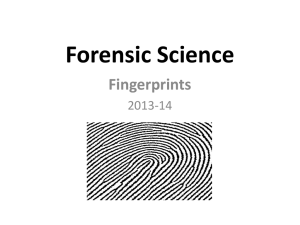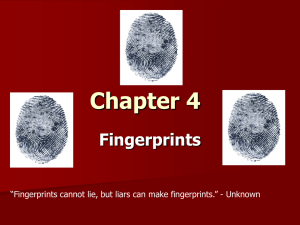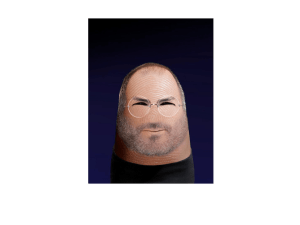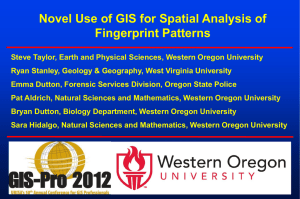what is a fingerprint? - Sewanhaka Central High School District
advertisement
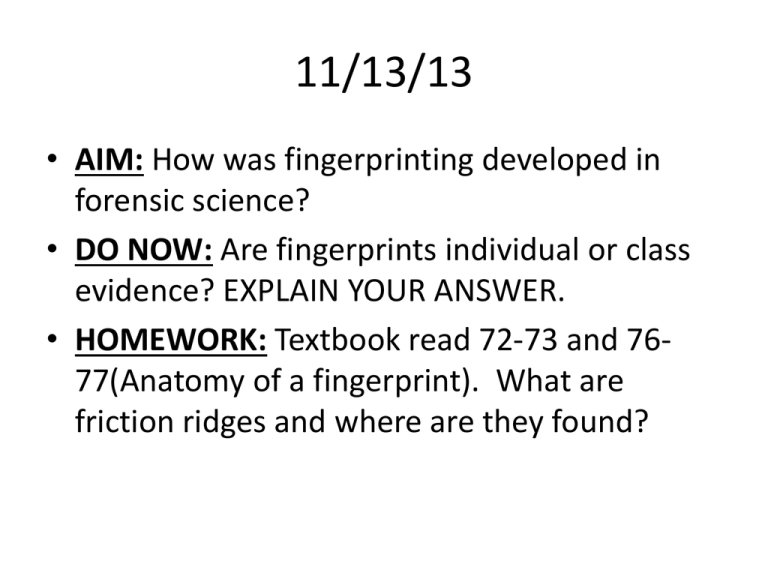
11/13/13 • AIM: How was fingerprinting developed in forensic science? • DO NOW: Are fingerprints individual or class evidence? EXPLAIN YOUR ANSWER. • HOMEWORK: Textbook read 72-73 and 7677(Anatomy of a fingerprint). What are friction ridges and where are they found? Dactyloscopy The study of fingerprints Historically William Herschel—required Indians to put their fingerprints on contracts, and also as a means of identifying prisoners Henry Faulds—claimed that fingerprints did not change over time and that they could be classified for identification Alphonse Bertillon—proposed body measurements as a means of identification; termed anthropometry Francis Galton—developed a primary classification scheme based on loops, arches and whorls. Edward Richard Henry—in collaboration with Galton instituted a numerical classification system Juan Vucetich—developed a fingerprint classification based on Galton’s that is used in Spanish-speaking countries William and Will west Fingerprinting Recording or Making Prints rolling inked prints primary identification number Lifting Prints Black, white and fluorescent powder Chemicals—ninhydrin, iodine, silver nitrate, cyanoacrylate Other Types of Prints Palm, lip, teeth, eye, ear, voice, shoe and footprints What is a fingerprint? • Skin has an outer layer (epidermis) which has ridges projecting inward, and an inner layer (dermis) which has projections pressing into the spaces between ridges • A fingerprint is a pattern made by the friction ridges, which is left behind due to sweat and oil that sticks to them. • Fingerprints form during the fetal stage of development. http://www.smithsonianmag.com/vi deo/Where-Do-Fingerprints-ComeFrom.html When do they form? • In early embryonic development & remain constant What determines fingerprints? • DNA - Genes • & environmental forces: pressures within the womb and contact with the amniotic fluid Formation of fingerprints • Skin layer growth – 3-4 month – Middle layer of skin buckles and folds creating the first ridges • Creation of ridges – fetus touches surrounding structures, exact position in the womb and the density of the womb's amniotic fluid determine how every individual ridge will form • Ridge patterns: 6 months – The ridges on a fetus's fingertips have formed three main patterns categorized as arches, loops and whorls • Fingerprint characteristics – two common characteristics found in every fingerprint: ridge end and bifurcation – The sequences of ridge end and bifurcation characteristics are different in every fingerprint Anatomy of Fingerprints • Epidermis – Outer layer of the skin • Dermis – Inner layer of the skin • Dermal papillae – Layer of cells between the epidermis and dermis – Responsible for determining the form and pattern of the ridges on the surface of the skin 11 Fundamental Principles of Fingerprints A fingerprint is an individual characteristic. A fingerprint will remain unchanged during an individual’s lifetime. Fingerprints have general characteristic ridge patterns that permit them to be systematically classified. Thursday 11/14/13 • AIM: How are imprints individual pieces of evidence? • DO NOW: Explain how fingerprints are formed • HOMEWORK: Textbook read pages 79-80. Answer questions 6-10 on page 100 • Wednesday hw: Textbook read 72-73 and 7677(Anatomy of a fingerprint). What are friction ridges and where are they found? DONOW ANSWER • DNA controls formation of epidermis and dermis • The pressure on the amniotic fluid finalizes the ridge pattern Fingerprint Ridges • • • • Give skin traction for picking up items. The fine lines curve, circle, and arch. Valleys - grooves or furrows Hills - friction ridges Fingerprint principle 1 • A fingerprint is an individual characteristic • no two fingers have yet been found to posses identical ridge characteristics Principle 2 • Fingerprints have general ridge patterns that permit them to be systematically classified Fingerprint Pattern • Pores on the ridges • Discharge perspiration from the sweat glands • Sweat mixed with oil can leave a latent invisible fingerprint Other Prints Ears—shape, length and width Voice—electronic pulses measured on a spectrograph Foot—size of foot and toes; friction ridges on the foot Shoes—can be compared and identified by type of shoe, brand, size, year of purchase, and wear pattern. Kendall/Hunt Publishing Company 19 Other Prints Palm—friction ridges can be identified and may be used against suspects. Other Prints Footprints are taken at birth as a means of identification of infants. Chapter 4 Other Prints Lips—display several common patterns Short vertical lines Short horizontal lines Crosshatching Branching grooves Chapter 4 Other Prints Teeth—bite marks are unique and can be used to identify suspects. These imprints were placed in gum and could be matched to crime scene evidence. Chapter 4 Other Prints The blood vessel patterns in the eye may be unique to individuals. They are used today for various security purposes. Chapter 4 Friday 11/15/13 AIM: how are fingerprints identified? DO NOW: List the three major characteristics used to identify fingerprints. Explain why each of your ten fingerprints are different. Chapter 4 Characteristics of fingerprints Chapter 4 Arch An arch has friction ridges that enter on one side of the finger and cross to the other side while rising upward in the middle. Types Plain- the arch is mild Tented- the arch is spiked upward Chapter 4 Plain arch Tented arch Loop A loop must have one or more ridges entering and exiting from the same side it began. Loops must have one delta (a“Y” pattern from diverging ridges) Types Radial--opens toward the thumb Ulnar--opens toward the “pinky” (little finger) Which type of loop is this, if on the right hand? Left hand? deltaΔ Whorl A Whorl has a minimum of 2 deltas. Types Plain- 2 symmetric deltas and a complete ridge circuit (circular in pattern) Central Pocket- 2 asymmetric deltas, one side appears to be stretched Double Loop- 2 loops and 2 deltas Accidental- a whorl that does not fit the 3 above pattern types Plain whorl 31 Central Pocket Whorl 32 Double Loop (whorl) 33 Accidental whorl 34 http://on.aol.com/video/howto-determine-fingerprintpatterns-72416331 Kendall/Hunt Publishing Company 35 • White lines in ridge patterns represent diet pattern. • Many white lines indicate celiac disease 36 Determining fetal environment • The more symmetrical your fingerprints the more stable the amniotic environment Kendall/Hunt Publishing Company 37 Monday 11/18/13 • AIM: how are fingerprints analyzed? • DO NOW: 1- What are the 3 general fingerprint patterns? 2-Explain the roll of the delta in fingerprint identification HOMEWORK: Using the class information, create a bar graph of the % of fingerprint patterns 2- Do the classroom % match the national average? Kendall/Hunt Publishing Company 38 Loops • Must have one delta 40 Whorls: 2 deltas Arches NO deltas Human population fingerprint distribution • Loops: 65% • Whorls: 30% • Arches: 5% FINGERPRINT IDENTIFICATION On your computer paper Thumb Right Hand Ridge pattern LeftHand Ridge pattern Index Middle Ring Pinky Thursday 11/21/13 • AIM: how are fingerprints compared? HOMEWORK:Textbook pg 100 questions 3-10. write out the question followed by the answer Identify each fingerprint pattern. Right Hand Left Hand Right Hand Right Hand Left Hand Fingerprint Identification • The uniqueness of a fingerprint can be determined by the pattern of ridges and valleys as well as the minutiae points. • Minutiae points are local ridge characteristics that occur at either a ridge bifurcation or a ridge ending. 49 Ridge Characteristics Minutiae—characteristics of ridge patterns Ridge ending Short ridge Dot or fragment Bifurcation Double bifurcation Trifurcation Bridge Island Enclosure Spur Kendall/Hunt Publishing Company 50 RIDGE CHARACTERISTICS (Minutiae) COMMON Ending Ridge OCCASIONAL RARE Fingerprint Basics (minutiae) Bifurcation dot Ridge ending Double bifurcation 52 Fingerprint Basics (minutiae) Opposed bifurcation Island (short ridge) Hook (spur) Lake (enclosure) 53 Fingerprint Basics (minutiae) Bridge Ridge crossing trifurcation Opposed bifurcation/ridge ending) 54 RIDGE CHARACTERISTICS MAGNIFIED 11 1 10 2 9 3 8 4 5 7 Points 1, 2, 4, 5 are Ending Ridges Points 8, 10, 11 are Bifurcations Point 7 Short Ridge 6 Points 3 and 9 are Dots Point 6 is an Enclosure (ISLAND) Fingerprint Minutiae Kendall/Hunt Publishing Company 56 How are fingerprints compared? A. Fingerprints are compared by noting the ridge pattern on two prints to determine whether or not they match. B. The minutiae characteristics are then compared C. An identification is established when a number of these characteristics occupy the same relative position on the two prints. Comparison There are no legal requirements in the United States on the number of points. Generally, criminal courts will accept 8 to 12 points of similarity. Activity: Sticky Fingers Fingerprints Modern Fingerprint Analysis Computer system stores patterns and minutiae of prints AFIS: automated fingerprint identification system FINGERPRINT IDENTIFICATION Primary Classification The Henry—FBI Classification Each finger is given a point value right left Kendall/Hunt Publishing Company 62 Primary Classification Assign the number of points for each finger that has a whorl and substitute into the equation: right index right ring left thumb left left middle little + 1 = right thumb right right middle little left left index ring +1 That number is your primary classification number Kendall/Hunt Publishing Company 63 Arches Arches are the simplest type of fingerprints that are formed by ridges that enter on one side of the print and exit on the other. No deltas are present. Spike or “tent” Plain Arch Ridges enter on one side and exit on the other side. Tented Arches Similar to the plain arch, but has a spike in the center. Loops Loops must have one delta and one or more ridges that enter and leave on the same side. These patterns are named for their positions related to the radius and ulna bones. Delta Ulnar Loop (Right Thumb) Loop opens toward right or the ulna bone. Radial Loop (Right Thumb) Loop opens toward the left or the radial bone. NOTE: On the left hand, a loop that opens to the left would be an ulnar loop, while one that opens to the right would be a radial loop. Whorls Whorls have at least one ridge that makes (or tends to make) a complete circuit. They also have at least two deltas. If a print has more than two deltas, it is most likely an accidental. Plain Whorl Central Pocket Whorl Draw a line between the two deltas in the plain and central pocket whorls. If some of the curved ridges touch the line, it is a plain whorl. If none of the center core touches the line, it is a central pocket whorl. Whorls – Part 2 Double Loop Whorl Accidental Whorl Delta Delta Double loop whorls are made up of any two loops combined into one print. Accidental whorls contain two or more patterns (not including the plain arch), or does not clearly fall under any of the other categories. WHAT IS A FINGERPRINT? A fingerprint is a pattern comprised of ridges and valleys. A Ridge – is a high. A Valley – is a depression or low. Friction ridges are also found on our palms, feet and toes. Ridge Valley Anatomy of fingerprints • Finger touches a surface –Perspiration –Oils from hairy portions of the body –Transferred onto surface • Leaves fingerprint 70 What is a Fingerprint? • Skin has an outer layer (epidermis) which has ridges projecting inward, and an inner layer (dermis) which has projections pressing into the spaces between ridges • A fingerprint is a pattern made by the friction ridges, which is left behind due to sweat and oil that sticks to them. • Fingerprints form during the fetal stage of development. 71 There are 3 types of fingerprints Visible – left by dirt, grease, blood, etc. 1. Does not need processing There are 3 types of fingerprints Impression – indentation in soft material (butter, putty, tar, etc.) 2. Does not need processing There are 3 types of fingerprints 3. Latent – requires processing to make visible and suitable for analysis What are the invisible components? Multiple sweat glands secrete onto fingers, palms, etc. Sweat contains: Inorganic ions (Na+, Cl -) Proteins, amino acids Lipids Other Lifting Latent Prints Developing a print requires chemicals that react with secretions that cause the print to stand out against its background. It may be necessary to attempt more than one technique, done in a particular order so as not to destroy the print. Powders--adhere to both water and fatty deposits. Choose a color to contrast the background. Iodine--fumes react with oils and fats to produce a temporary yellow brown reaction. 76 Physical Development: Dusting Apply powder to latent print or area. Powder adheres to print. Brush and Powder Physical Development: Dusting Apply powder to latent print or area. Powder adheres to print. Magnetic Brush and Powder Lifting Latent Prints (cont) Ninhydrin--reacts with amino acids to produce a purple reaction. Silver nitrate--react with chlorides to form silver chloride, a material which turns gray when exposed to light. Cyanoacrylate--”super glue” fumes react with water and other fingerprint constituents to form a hard, whitish deposit. In modern labs and criminal investigations, lasers and alternative light sources are used to view latent fingerprints. It was first used by the FBI in 1978. Since lasers can damage the retina of the eye, special precautions must be taken and a filter used. 79 Chemical Development: Silver Nitrate 1. No longer used (messy, not sensitive) Silver reacts with Cl - ions in print Fingerprints > Analysis Chemical Development: Iodine Fuming 2. Iodine sublimes (solid → gas) Iodine reacts with lipid components; becomes trapped in the print. Fuming wand or chamber Dirty Brown Color Iodine Fingerprint 82 Chemical Development: Ninhydrin 3. Reacts with amino acids; purple color Painted or sprayed on area Heated to react Ninhydrin Fingerprint 84 Chemical Development: Super glue fuming 4. Fumes with heat or base (NaOH) Fumed in cabinets Off-white print Cyanoacrylate Fingerprints 86 Chemical Development: Ninhydrin and super glue prints can be further processed: Dusted Chemically treated to fluoresce (using laser or alternative light)

